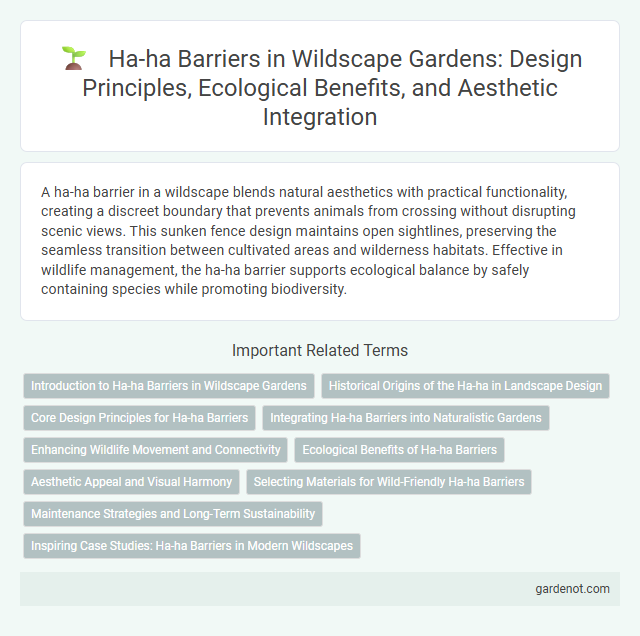A ha-ha barrier in a wildscape blends natural aesthetics with practical functionality, creating a discreet boundary that prevents animals from crossing without disrupting scenic views. This sunken fence design maintains open sightlines, preserving the seamless transition between cultivated areas and wilderness habitats. Effective in wildlife management, the ha-ha barrier supports ecological balance by safely containing species while promoting biodiversity.
Introduction to Ha-ha Barriers in Wildscape Gardens
Ha-ha barriers in Wildscape gardens serve as discreet boundary structures that blend seamlessly with the natural landscape, preventing animal movement without obstructing views. These sunken walls or ditches maintain the aesthetic integrity of the garden while providing effective containment for wildlife in conservation areas. Their design minimizes visual disruption and promotes safe interaction between visitors and the natural environment.
Historical Origins of the Ha-ha in Landscape Design
The Ha-ha barrier, originating in 18th-century English landscape design, served as a recessed landscape feature that maintained uninterrupted views while preventing livestock from crossing boundaries. This design innovation reflected the Georgian era's emphasis on blending aesthetic beauty with practical fencing solutions in garden and estate planning. Its historical implementation reshaped the relationship between nature and human habitation by seamlessly integrating safety with visual openness.
Core Design Principles for Ha-ha Barriers
Ha-ha barriers are designed with core principles emphasizing unobtrusive safety and seamless integration into the landscape, ensuring clear views while preventing animal or human crossing. The structure relies on a recessed trench combined with a vertical retaining wall, maintaining natural sightlines crucial for landscape aesthetics and wildlife movement control. Effective ha-ha design balances functional containment with ecological harmony, using materials and dimensions that support both durability and minimal visual impact.
Integrating Ha-ha Barriers into Naturalistic Gardens
Ha-ha barriers create unobtrusive boundaries in naturalistic gardens by using a recessed wall that maintains uninterrupted sightlines, blending seamlessly with the landscape design. This technique preserves the aesthetic flow and enhances the experience of open, wildlife-friendly spaces while effectively containing livestock or defining garden areas. Integrating ha-ha barriers supports habitat connectivity and promotes ecological balance by minimizing physical and visual disturbances for local fauna.
Enhancing Wildlife Movement and Connectivity
Ha-ha barriers in wildscape design create unobtrusive fences that maintain visual openness while effectively containing animals, promoting natural wildlife movement. These sunken walls prevent physical barriers from disrupting animal pathways, enhancing habitat connectivity across fragmented landscapes. Integrating ha-ha barriers supports ecological corridors, reduces human-wildlife conflicts, and fosters biodiversity conservation.
Ecological Benefits of Ha-ha Barriers
Ha-ha barriers enhance landscape connectivity by providing an unobtrusive boundary that promotes wildlife movement and habitat continuity. Their design minimizes physical barriers for small mammals, amphibians, and reptiles, supporting biodiversity within gardens and estates. By reducing the need for fencing, ha-ha barriers also prevent habitat fragmentation and maintain natural water drainage patterns, contributing to healthier ecosystems.
Aesthetic Appeal and Visual Harmony
The Ha-ha barrier seamlessly blends functionality with aesthetic appeal, creating an uninterrupted visual harmony between landscaped gardens and adjoining areas. Its sunken design preserves sightlines while maintaining safety, allowing natural scenery to flow smoothly without intrusive fencing. This subtle boundary enhances the overall beauty of Wildscape environments, promoting a tranquil and cohesive outdoor experience.
Selecting Materials for Wild-Friendly Ha-ha Barriers
Choosing materials for wild-friendly ha-ha barriers involves using natural stone or locally sourced bricks to blend seamlessly into the environment while ensuring durability against weather and wildlife wear. Incorporating rough textures and varying stone sizes fosters vegetation growth and provides microhabitats for small animals and insects. Sustainable sourcing, such as reclaimed materials, minimizes ecological impact and supports conservation efforts within wildscape designs.
Maintenance Strategies and Long-Term Sustainability
Effective maintenance of Ha-ha barriers in wildscapes involves regular inspection to prevent soil erosion and structural damage, preserving both aesthetic appeal and functional integrity. Implementing sustainable landscaping techniques like native plantings around the barrier supports ecosystem health while reducing the need for intensive upkeep. Long-term sustainability relies on integrating adaptive management practices that respond to environmental changes, ensuring minimal habitat disturbance and prolonged barrier effectiveness.
Inspiring Case Studies: Ha-ha Barriers in Modern Wildscapes
Ha-ha barriers in modern wildscapes offer innovative solutions for unobtrusive wildlife containment, blending seamlessly with natural landscapes while maintaining safety and aesthetic appeal. Case studies demonstrate successful integration of ha-ha barriers in conservation parks and urban green spaces, promoting biodiversity without disrupting visitor experience. Designs often incorporate local materials and adaptive engineering, highlighting sustainable practices that inspire future wildscape projects globally.
Ha-ha barrier Infographic

 gardenot.com
gardenot.com